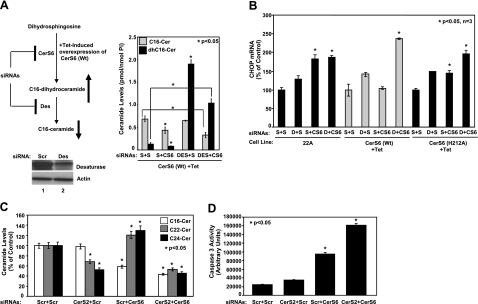Figure 4.
Dissection of the roles of dihydroceramide or ceramide in the regulation of ER stress. A) Left panel: schematic representation of the experiments carried out to dissect the roles of C16- or dh-C16-ceramides in the prevention of CHOP activation and ER stress. Right panel: C16- and dh-C16-ceramide levels of Tet-induced UM-SCC-22A cells expressing CerS6 (WT) after transfections with Scr, Des, or CerS6 siRNAs were measured by LC/MS. Down-regulation of Des using siRNA in UMSCC-22A cells compared with nontargeting scrambled siRNA-treated cells was confirmed by Western blotting (bottom panel, lanes 2 and 1, respectively). Actin levels were used as controls. B) Control UM-SCC-22A (22A) cells and Tet-induced (+Tet) UM-SCC-22A cells expressing either WT or catalytically inactive mutant (H212A) CerS6 were transfected with Scr (S), Des (D), or CerS6 (CS6) siRNAs (20 nM) alone or in combination (S+S, D+S, S+CS6, and D+CS6) for 48 h, and their roles in the regulation of CHOP mRNA levels were measured by Q-PCR. C, D) Roles of down-regulation of CerS2 and CerS6, alone or in combination, in the regulation of ceramide levels (C) and activation of caspase 3 (D) were detected by LC/MS and caspase activity assay, respectively. Bars represent means ± sd from 2 experiments done in duplicates. *P < 0.05.

